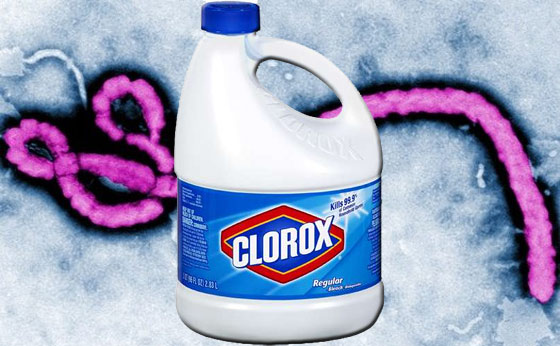Ebola Virus Disinfection With Bleach
How much regular bleach to use for Ebola virus disinfection?
How much bleach to add with water for a bleach-water solution to disinfect the Ebola virus?
Here’s your answer:
Surprisingly, the CDC website did not offer a direct answer to this question (that I could find). Their ‘interim guidance‘ regarding Ebola virus disinfection is less than direct.
Here’s what I mean by that:
Enveloped viruses such as Ebola are susceptible to a broad range of hospital disinfectants used to disinfect hard, non-porous surfaces. In contrast, non-enveloped viruses are more resistant to disinfectants. As a precaution, selection of a disinfectant product with a higher potency than what is normally required for an enveloped virus is being recommended at this time. EPA-registered hospital disinfectants with label claims against non-enveloped viruses (e.g., norovirus, rotavirus, adenovirus, poliovirus) are broadly antiviral and capable of inactivating both enveloped and non-enveloped viruses.
Begin by looking at the product label or product insert or, if these are not available, search the EPA search engine for this information. Users should be aware that an ‘enveloped’ or ‘non-enveloped virus’ designation may not be included on the container label. Instead check the disinfectant’s label for at least one of the common non-enveloped viruses (e.g., norovirus, rotavirus, adenovirus, poliovirus).
Check the disinfectant’s label for specific instructions for inactivation of any of the non-enveloped viruses.
-the CDC
TRANSLATION:
You can use Regular Clorox® Bleach for Ebola virus disinfection.
While there are apparently a number of products-manufacturers of disinfecting solutions, the CDC fails to identify any of them directly – for Ebola virus (that I could find while searching their website). This seems to be a disservice and/or a cover-your-a$$ approach.
From the Clorox® website:
Household disinfectants such as Clorox® Regular-Bleach and Clorox® Disinfecting Wipes meet the criteria currently recommended by the CDC for hospitals.
How Much Bleach With Water For Ebola Virus Disinfection
Add 1 part bleach to 9 parts water (1:10 dilution factor)
From the Public Health Agency of Canada:
EBOLA VIRUS SUSCEPTIBILITY TO DISINFECTANTS:
Ebolavirus is susceptible to 3% acetic acid, 1% glutaraldehyde, alcohol-based products,and dilutions (1:10 – 1:100 for ≥10 minutes) of 5.25% household bleach (sodium hypochlorite), and calcium hypochlorite (bleach powder).
The WHO recommendations for cleaning up spills of blood or body fluids suggest flooding the area with a 1:10 dilutions of 5.25% household bleach for 10 minutes for surfaces that can tolerate stronger bleach solutions (e.g., cement, metal).
For surfaces that may corrode or discolor, they recommend careful cleaning to remove visible stains followed by contact with a 1:100 dilution of 5.25% household bleach for more than 10 minutes.
Note: While the Ebola virus disinfection advice given above references 5.25% bleach, today’s newer regular bleach is typically 8.25% concentration (of sodium hypochlorite) and therefore a bit stronger (implying a slightly less required bleach-to-water ratio). However, given the use-case scenario (Ebola virus) I would still follow the same recommendation of 1 part regular bleach to 10 parts water (a slightly stronger solution will only help matters while using 8.25% regular bleach).
Example: To make a bit more than half a gallon of Ebola virus disinfectant, simply use a 1-cup measuring cup and dump 1 cup of regular bleach into a bucket, and then add 9 cups of water.
If anyone finds more specific information from the CDC or WHO, regarding bleach-to-water ratio for disinfecting Ebola virus, let us know…
For those of you in health care, hospital workers, etc., what are you being told regarding Ebola virus disinfection (if anything)?

